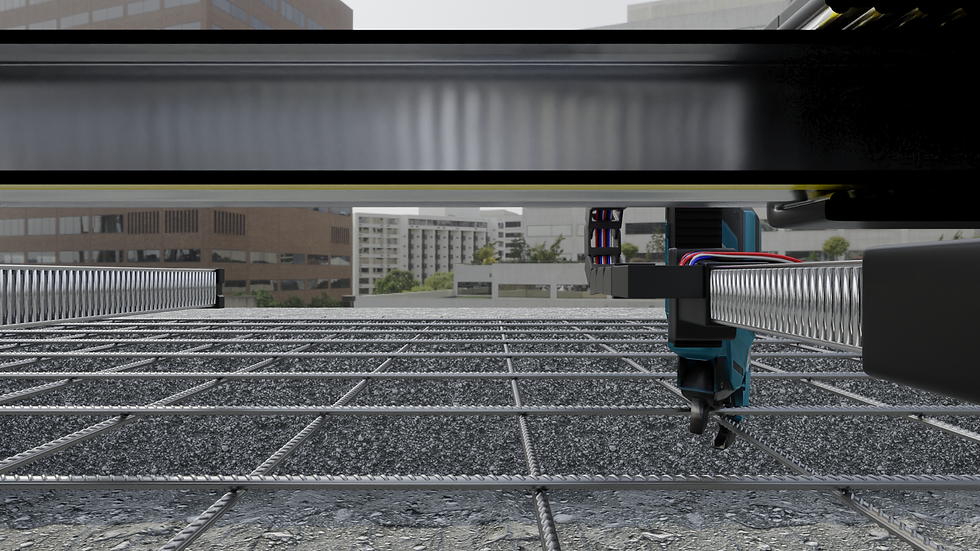Boosting Construction Efficiency With TSpider’s Autonomous Rebar Tying
- TSpider

- Aug 10
- 3 min read

The construction sector is under constant pressure to deliver projects on time and within budget, but persistent labor shortages and demanding safety requirements make this challenging. One of the most labor-intensive phases—rebar tying—has long been a bottleneck in productivity. Traditional methods rely heavily on manual labor, requiring teams of skilled workers to complete thousands of ties, often in difficult conditions.
TSpider offers a solution through full automation. This autonomous rebar knitting robot uses advanced AI and a 360° panoramic camera to detect and secure every rebar intersection without human intervention. Equipped with four tying guns integrated into its legs, it delivers rapid, consistent ties while maintaining stability across both horizontal and vertical structures. Its adaptability to different site conditions, weather resistance, and multiple battery options make it a reliable choice for improving efficiency across a wide range of construction projects.
Why Automation Is Needed in Rebar Tying
Rebar tying demands precision and speed, yet it is also one of the most repetitive and physically taxing jobs on a construction site. Workers must bend, kneel, or reach for extended periods, increasing the risk of repetitive strain injuries. The physical toll often leads to reduced productivity as shifts progress, while fatigue can compromise tie quality.
Large-scale projects, such as bridges and high-rise buildings, require hundreds of thousands of ties. Achieving consistent quality under these conditions is difficult, and delays in tying can hold up other stages of construction. With skilled labor becoming harder to find, contractors face growing challenges in maintaining productivity and meeting deadlines without compromising worker safety.
Automation addresses these issues by providing a consistent, fatigue-free workforce that can operate for extended periods without breaks, ensuring faster completion and improved quality control.
Inside the TSpider’s Technology
TSpider’s performance comes from a combination of AI-driven navigation, mechanical precision, and adaptive design. Its 360° camera feeds real-time visual data to the onboard AI, which identifies every rebar intersection and plans an optimized route for maximum efficiency. This ensures complete coverage without unnecessary movement.
The four-leg tying system allows TSpider to create multiple ties with each step, increasing speed and ensuring stability as it moves across the structure. The design works equally well on horizontal decks, vertical walls, and complex architectural shapes.
Multiple battery options provide flexibility for long or short shifts, while the robust frame and weatherproof construction allow it to operate in conditions that would typically halt manual tying. Quick assembly and portability make it practical for both large-scale operations and smaller, fast-moving projects.
Real-World Advantages for Construction Projects
TSpider’s impact is most evident on projects where speed, consistency, and safety are critical. On large bridge or high-rise builds, it can handle hundreds of thousands of ties without the fatigue or variability associated with manual labor. This reduces the risk of missed intersections, which can compromise structural integrity and require costly rework.
By automating the most repetitive aspects of rebar tying, TSpider frees skilled workers to take on higher-value tasks such as inspection, measurement, and quality control. This reallocation of labor not only improves overall project efficiency but also enhances worker satisfaction by reducing physically taxing duties.
Its ability to function in challenging weather conditions means fewer delays and more predictable timelines. For smaller contractors, the option to use different battery types helps lower operating costs while still delivering high performance. In every case, TSpider contributes to safer working conditions, faster project completion, and measurable cost savings.
Redefining Construction Productivity
TSpider demonstrates how automation can address some of the construction industry’s most persistent challenges. With its AI navigation, panoramic vision system, and multi-leg tying design, it offers a combination of speed, accuracy, and adaptability that manual methods cannot match.
By reducing labor strain, improving tie quality, and enabling work to continue in varied conditions, TSpider not only accelerates project timelines but also helps create safer and more efficient construction sites. Whether deployed on large infrastructure projects or smaller builds, it stands out as a forward-looking investment for companies aiming to stay competitive in a rapidly evolving market.




Comentários